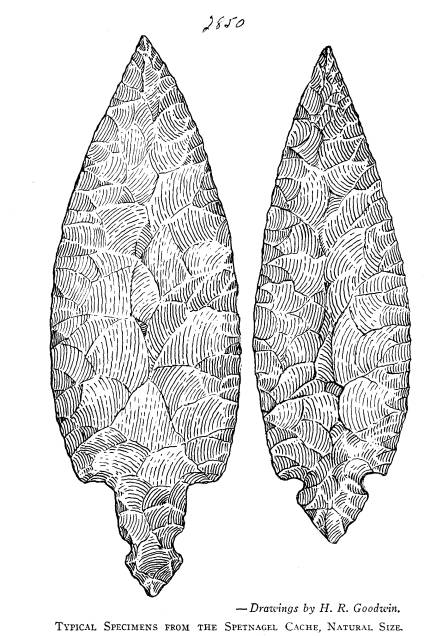Ohio History Journal
|
|
|
-- Drawings by H.R. Goodwin. (638) TYPICAL SPECIMENS FROM THE SPETNAGEL CACHE, NATURAL SIZE. |
THE SPETNAGLE CACHE OF FLINT
SPEAR-POINTS
Few better examples of ceremonial
offerings of
chipped flint artifacts than the
Spetnagel cache of flint
spear-points, recently placed on
exhibition in the Mu-
seum of the Society by Mr. Albert C.
Spetnagel, of
Chillicothe, have been found in Ohio or
elsewhere. This
remarkable cache-lot of upwards of 200
ceremonial
spears was unearthed in the spring of
1922 in excavat-
ing the basement for a dwelling-house
in the northern
suburbs of Chillicothe. The discovery,
coming to the
attention of Mr. Frank Grubb, a member
of this So-
ciety, was reported to Mr. Spetnagel,
who immediately
took steps to secure the specimens. It
developed that
workmen on the building contract had
come upon the
offering at a depth of about eighteen
inches below the
surface, placed apparently in some
order but without ac-
companying skeletal remains or any
particular prepara-
tion. Evincing no interest in the find,
the workmen per-
mitted scrapers to drag the specimens
out into the gar-
den lot where the earth was being used
for grading
purposes. At considerable expense Mr.
Spetnagel had
this earth carefully examined and thus
recovered the
specimens so carelessly disposed of. In
addition, he se-
cured from numerous individuals
specimens which had
been carried away as curios.
The ceremonial spears, upwards of 200
in number,
are chipped from the drab nodular flint
found in south-
ern Indiana and in Tennessee. They
range in length
(639)
640
Ohio Arch. and Hist. Society Publications
from 3 inches to 10 1/2 inches, and are
of two types, as
shown in the accompanying drawing, by
H. R. Good-
win, of the Museum staff, which
illustrates typical speci-
ments in their natural sizes. By far
the greater num-
ber are of the type of the smaller of
the two spears illus-
trated.
A regrettable feature of the find is
the fact that
prior to depositing the spear-points in
the shrine-like
aperture, the aboriginal owners
intentionally broke
them -- the ceremonial
"killing", so often observed in
exploring mounds of the great Hopewell
culture group.
Fortunately a number of the specimens
were only
slightly broken, or were fractured into
but two or three
parts, so that about one-half the
entire number were
readily re-united and restored. They
completely fill a
large display case in the Museum, in
close proximity to
the specimens from the Mound City group
in Camp
Sherman. The nearness of the site of
the cache-find to
the mounds in Camp Sherman, together
with the fact
that the ceremonial spear-points
apparently belong to
the same (Hopewell) culture, indicate
strongly that the
builders of the Mound City mounds were
the original
possessors of the spears.
It is presumed that this unusually
large and finely
made lot of spears were deposited where
found as an
offering to some deity of the ancient
inhabitants of the
present Ross county.
